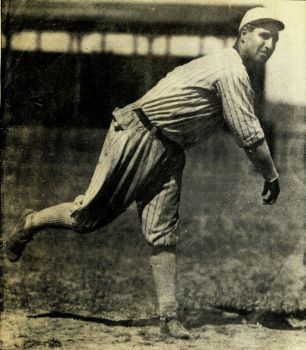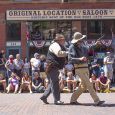The Gift of South Dakota
Subscriptions to South Dakota Magazine make great gifts!
Subscribe today — 1 year (6 issues) is just $29!
South Dakota’s Death Valley
Major League Baseball has long been known for its blend of interesting and controversial characters. One of the most interesting of the pre-1920 era was Deadwood native James "Death Valley" Scott.
Scott was enshrined in the South Dakota Sports Hall of Fame in 1985 for his nine years of excellence as a big league pitcher for the Chicago White Sox. He is unquestionably the most successful pitcher among native South Dakotans.
Scott was born in Deadwood on April 23, 1888. His father, George, was a weatherman and telegraph operator for the government. The Scotts moved to the Standing Rock Indian Reservation west of Mobridge and later to Lander, Wyoming. It was in the country fields around Lander at the turn of the century where Scott first found the joys of hurling a baseball past aspiring hitters.
Scott refined his pitching skills as a one-year college student at Kansas Wesleyan. He also spent one summer at Oskaloosa, Iowa, pitching for a semi-pro team. In 1908, Scott signed on with a Wichita, Kansas, team in the Western League. After only one season of professional baseball, he was sold to the Chicago White Sox and made his debut in the big leagues and celebrated his 21st birthday just days apart. He spent nine years in the majors, all with the Sox.
Scott's first appearance in a major league game was indicative of his career to follow. He won his debut 1-0, and he was glorified in print the day following by noted sports journalist Ring Lardner, who covered the game for a Chicago newspaper.
In his 1909 rookie season, Scott went 13-12, through his won-loss record is somewhat misleading. He pitched five shutouts that summer and was on the losing end of five 1-0 games. Scott lost four other games by a 2-1 score. It was the harbinger of his career.
The following year, Scott posted a 9-17 record for the White Sox. He spent that winter in Imperial, California, and upon his return for the 1911 season, he was quickly dubbed "Death Valley" after the legendary desert character called Death Valley Scotty.
The next two seasons were so-so for the tall, burly 235-pound, right-handed pitcher. In 1911 he was 12-11 and the following year only 2-2 as he saw limited pitching time.
But over the next three seasons, Scott was as good as any pitcher in major league baseball. In 1913, he was not only a 20-game winner but a 21-game loser for a second division ball club. He fashioned an outstanding 1.90 earned run average and highlighted the year in a game against the St. Louis Browns when he struck out 15 batters, including six in succession. Scott pitched in 48 games and totaled 312 innings that summer.
Scott's hard luck pitching was perhaps personified in the 1914 season when he pitched a no-hitter .... and lost. His record was 16-18 that year, and his toughest loss occurred on May 14 when he shut out the Washington Senators on no hits for nine innings only to lose the no-hitter and the game, 1-0, in the 10th inning.
(According to no-hitter historian Dirk Lammers, in 1991, the Committee for Statistical Accuracy amended its definition of a no-hitter, "declaring it a game of nine innings or more that ends with no hits." Scott's "no-hitter" was officially wiped from the record books, along with 49 other such games that had been played throughout the history of Major League Baseball. Learn about them at Lammers' website, www.nonohitters.com.)
His biggest season was 1915. Scott won 24 games in 35 decisions and led the league with seven shutouts. This was also the year that he was on the mound when Detroit Tiger Hall of Famer Ty Cobb's 35-game hitting string came to an end.
Scott's record slipped to 9-14 the following year. In 1917, he was 6-7 with a sparkling 1.87 earned run average when he left the team in the middle of the season and enlisted in the U.S. Army. He was the first major leaguer to do so. He later earned a commission as a captain before his discharge in 1920.
His major league totals for nine years read 111 wins, 113 losses, 26 career shutouts and a 2.32 career earned run average. Scott's career was noted by his character and sportsmanship almost as much as his superb curveball and deft pickoff move to first base.
Scott was one of the first baseball players to form a link with the world of show business. He and White Sox teammate Buck Weaver were married to two of the four Cook Sisters, whose singing act was the talk of Chicago in those days.
In 1914, Scott took his turn on the mound as the White Sox and the New York Giants spent the off-season touring places such as England, Paris and Tokyo. He even pitched before the Pope at the Vatican.
It was while Scott was at war that the famous Black Sox Scandal occurred. It involved eight White Sox players who contrived with gamblers to throw the 1919 World Series. In his later days, Scott confided to his son, "Had I still been with the team in 1919, it never would have happened. When I found out about it, I would have reported it for the honor of the game.”
Scott returned to baseball after his military service, but not to the White Sox. He refused an invitation because of conflicts with team management. Instead, he finished his professional career in the minor leagues, pitching four seasons with the San Francisco Seals of the Pacific Coast League and two years for the New Orleans Pelicans of the Southern League.
In 1923, Scott needed permission from Pacific Coast League president W.H. McCarthy to wear a mustache on the playing field. Such facial hair had long been taboo in pro baseball. Scott grew the mustache as a result of a winter Canadian hunting trip. It quickly became a good luck piece, as he pitched a no-hitter in one of his first games that year.
His playing days ended the summer of 1927, when he suffered a broken leg. Scott remained active in baseball, working as an umpire in the Southern League. In 1930, he became one of the few big-league baseball players ever to return to the majors as an umpire, working for three National League seasons.
During his minor league days in the Pacific Coast League, Scott worked winters in the movie studios. Following his retirement from umpiring, he went to work full time with such major studios as Warner Bros., RKO and Republic Pictures. He retired in 1951 and died on April 7, 1957 in Palm Springs.
Although he left South Dakota at an early age, there was a return of sorts in 1939 when his son, Jim Scott, Jr., pitched for the Northern League Sioux Falls Canaries under manager Rex Stucker. Years later, the younger Scott compared his own and his father's pitching skills. “I was a thrower,” he said. “Dad was a pitcher.”
Editor’s Note: This story is revised from the November 1986 issue of South Dakota Magazine. To order a copy or to subscribe, call (800) 456-5117.











Comments